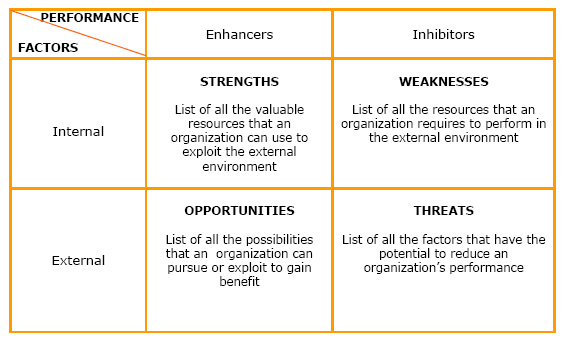Difference between revisions of "SWOT Analysis"
From Learning and training wiki
Chantal joly (Talk | contribs) |
Chantal joly (Talk | contribs) |
||
| Line 4: | Line 4: | ||
{{Tool|Conducting a SWOT Analysis| | {{Tool|Conducting a SWOT Analysis| | ||
__NOTOC__ | __NOTOC__ | ||
| − | To conduct a SWOT analysis identify the following four categories of the [[#Swot Matrix|SWOT | + | To conduct a SWOT analysis identify the following four categories of the [[#Swot Matrix|SWOT Matrix]]: |
#'''Strengths''' : An internal competence, valuable resource or attribute that an organization can use to exploit the external environment. For example : competitive advantages, resources, certifications, experience, management cover, communication. The aim of the SWOT is to maintain, build, and leverage. | #'''Strengths''' : An internal competence, valuable resource or attribute that an organization can use to exploit the external environment. For example : competitive advantages, resources, certifications, experience, management cover, communication. The aim of the SWOT is to maintain, build, and leverage. | ||
Revision as of 09:38, 15 October 2008
| A tool that identifies the Strengths, Weaknesses, Opportunities and Threats of an organization. Specifically, SWOT is a basic, straightforward model that assesses what an organization can and cannot do as well as its potential opportunities and threats. The SWOT analysis takes the information from an environmental analysis and separate it into internal (strengths and weaknesses) and external issues (opportunities and threats). Once this is completed, the SWOT analysis determines what can be of assistance to the organization in accomplishing its objectives, and what obstacles must be minimized to achieve desired results. [1] |
|
To conduct a SWOT analysis identify the following four categories of the SWOT Matrix:
Strengths and Opportunities are identified as enhancers to desired performance, while Weaknesses and Threats are inhibitors.[2]
SWOT Matrix
Step by Step
The situation is then analyzed with the objective of identifying ways in which the organization’s strengths can be built,upon to overcome the identified weaknesses, and opportunities can be taken to minimize threats. A strategy for making improvements is formulated and subsequently developed, using any planning tool. [3]
Job Aids
|
References
- ↑ www.answers.com (20 August 2008), www.netmba.com (20 August 2008), en.wikipedia.org (20 August 2008)
- ↑ www.businessballs.com (3 October 2008), web.worldbank.org
- ↑ www.quickmba.com (13 August 2008), Wikipedia (13 August 2008), Project Cycle Management Guidelines, European Commission, 2004
